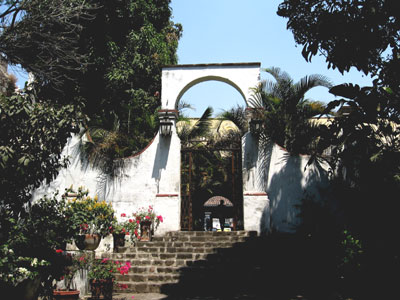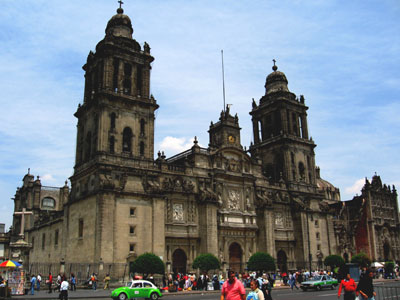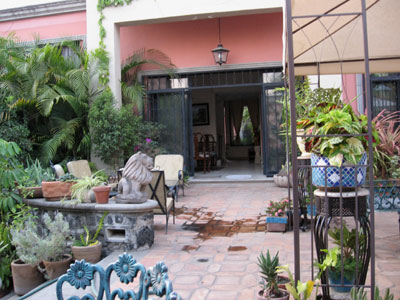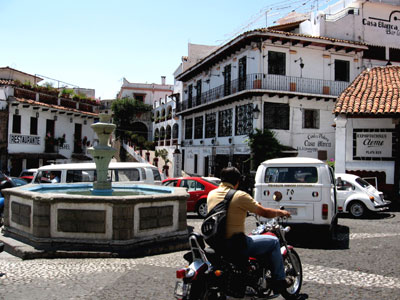spend my mornings in Cuernavaca studying Spanish and I arranged to have the afternoons free to explore the city. At the Ideal language school today I had chance to talk with the founder, Hermilo Brito, to find out more about his school and its history.
He explained that he founded his school in 1975 after he had already worked for another language teaching institution. Originally he had a partner, but they parted ways after a while. His motto has always been to strive to improve and he keeps restructuring the school in this spirit. Hermilo mentioned that his staff are highly educated and all of them have teaching degrees.

Hermilo (right) with one of his teachers (left) and a local candy vendor (centre)
We had an interesting talk about Mexican culture, that people here work to live, rather than living to work as so many of us do in northern countries. We also touched on the new concept of “voluntourism” and the immigrant situation in various European countries. Another topic we discussed was the perception of Mexican immigrants in US, and that they are perceived mostly as having little or no education, and that many Mexican immigrants in the United States are part of the lower economic classes. Especially at the moment, immigration, or the migration of people in general, is a touchy subject in many countries, including the United States and Europe.

Beautiful chapel right next to the Cathedral of Cuernavaca
Hermilo also filled me in about Ideal’s language teaching methodologies. He is familiar with the the techniques used by the US. State Department, the natural language learning technique and his school has integrated these approaches into a new technique: the immersion learning technique which involves as much interaction as possible with the locals. This includes staying with a local family to speak Spanish all the time and to get to know Mexican culture from the perspective of an insider. Hermilo also pointed out that Ideal generally offers pronunciation classes to its students after 6 weeks after they have sufficiently acclimatized themselves to the language in Mexico.
Today I also had an opportunity to meet Marta, a woman from University of Madrid who is evaluating Ideal Latinoamerica for membership in the Instituto Cervantes, a Spain-based institution with offices world wide to promote the teaching of Spanish and related cultural activities.
After school I had a lovely little lunch in Calle Camacho, the street just below my language school. I love vegetarian food and strangely enough my appetite in Mexico has drastically shrunk. I just find that my cravings for heavy meals have disappeared and I try to eat as lightly as I can.

One of the 3 chapels surrounding Cuernavaca’s cathedral
So I tried a so-called Ensalada de Palmitos (a salad with palm hearts) which was really delicious. I guess the reduced appetite combined with all the walking that I am doing here is a pretty good combination….
After my lovely lunch I took a local bus to the Zócalo where I rested a little and just watched the world pass by. An older gentleman wanted to read to me from the bible, a young lady wanted to sell me jewellery, and another gentleman wanted to sell me the smallest violin in the world. What can I say, just another day at the office….
But never mind, I made my way to the Museo Robert Brady, right next to the Cathedral. Robert Brady was an American painter, art collector and jet setter who lived in Cuernavaca from 1962 to 1986 when he passed away from liver cancer.

Sitting room in the Robert Brady Museum
In his house, which used to be part of the convent, he had many famous guests: Josephine Baker, Rita Hayworth, Peggy Guggenheim (who gave him the idea to bequeath his house as a museum since he didn’t have family). Maria Callas, Candice Bergen, Ali McGraw and many other celebrities have stayed here and enjoyed the company of this . Many members of royal families, artists and ambassadors visited him as well. Robert Brady was a successful artist and a wealthy man, part of the 1960s jet-set.

Art by Robert Brady
My tour guide explained that Robert Brady was, like so many artists, a somewhat eccentric man, and he liked to wear caftans which he brought home with him from some of his international trips. Brady was born in Iowa and studied fine arts at the Art Institute of Chicago, The Tyler Arts Center of Temple University and the Barnes Foundation in Merion, Pennsylvania. He lived in Venice, Italy, for five years before establishing himself in Cuernavaca.

Second bathroom in the Robert Brady Museum
His house holds a collection of fine and decorative arts from all over the world in a house that used to be part of a 16th century Franciscan monastery. His collection consists of more than 1300 pieces and includes artwork by such famous painters as Rufino Tamayo, Frida Kahlo, Miguel Covarrubias, Maurice Prendergast, Marsden Hartley and Graham Sutherland. Around 20,000 visitors come to the Robert Brady Museum every year.
The house is beautiful house and each room is intensely coloured and widely different from all the others. The house has a beautiful interior courtyard, with an amate tree perched up high on a ledge, with intertwined roots stretching down to the ground. One corner of the courtyards holds a small café, the perfect place to relax and cool down from exploring downtown Cuernavaca.

An amate tree is anchored high on a wall
My museum guide also told me that Cuernavaca is also called “La Ciudad detras las Paredes” – the city behind the walls. How true, there are so many wonderful patios and interior courtyards in this city, but from outside you just see nondescript walls.
After my visit to the Robert Brady Museum I decided to explore another famous sight in Cuernavaca: the Jardín Borda, a famous garden just opposite the Cathedral. The estate includes an enormous residence that was the home of José de la Borda, owner of the silver mines in the famous silver city of Taxco, also the creator of the famous Santa Prisca Cathedral in the same city. The residence dates back to the late 1700s, and Emperors Maximilian and Carlotta lived here in the 1860s during their brief reign of Mexico. Today it is one of Cuernavaca’s cultural centers. Various art exhibitions and cultural events and you can also find a cafe and a small bookstore here.

One of the many fountains in the Jardín Borda
The gardens themselves are a real oasis of calm inside a hustling and bustling city. When it gets really hot in Cuernavaca, shade is really difficult to find, and the Jardin Borda’s lush subtropical gardens offer shade and tranquility as well as beautiful fountains and pools.
Because my B&B hostess Marta Elena was having me over for a dinner tonight, I wanted to pick up a little gift for her and I know she absolutely loves flowers. I succeeded in finding some at the local “mercado“, an adventure in itself.

Entrance gate to the Jardín Borda
Now I am just waiting for my physiotherapy appointment which is scheduled for 5:30 pm. And then at 7:30 pm a dinner is planned with Marta Elena and Roxana Villamichel from Cuernavaca’s tourism department, who’s been so helpful in helping me design my itinerary.




